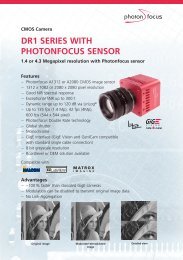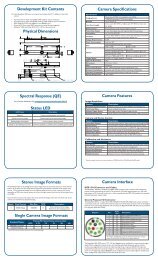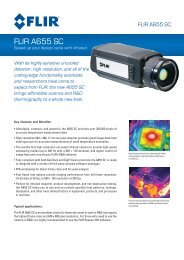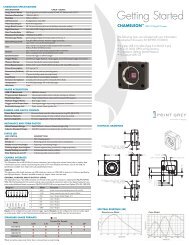Create successful ePaper yourself
Turn your PDF publications into a flip-book with our unique Google optimized e-Paper software.
Point Grey <strong>Blackfly</strong> Technical Reference<br />
2 <strong>Blackfly</strong> Installation<br />
Changing the packet size may impact throughput depending on the packet delay setting.<br />
2.4.3.2 Packet Delay<br />
The stream channel packet delay (SCPD) indicates the number of ticks (at the frequency of the Timestamp Tick<br />
Frequency) to insert between each packet. The default packet delay is 400.<br />
The Point Grey Timestamp Tick Frequency is normally 125,000,000 ticks/second, but can be verified by the the<br />
GevTimestampTickFrequency GenICam feature, or the Timestamp Tick Frequency Bootstrap register (page 74).<br />
The packet delay acts like a gap between packets during transmission. This delay allows the host to process the current<br />
packet before the arrival of the next one. When you increase the packet delay value from zero, you reduce the<br />
effective bandwidth assigned to the camera and thereby also reduce the possibility of dropped frames.<br />
Increasing the packet delay is recommended when running multiple cameras through an Ethernet<br />
switch.<br />
Increasing the packet delay may require the frame rate to be reduced to meet the available maximum bandwidth.<br />
Achieving a desired frame rate may require decreasing the packet delay.<br />
To adjust the packet delay:<br />
Packet delay for the camera can be adjusted using the FlyCap demo program, the GevSCPD GenICam feature (page<br />
65), or the GigE Vision bootstrap registers (page 74). The FlyCapture SDK also supports configuring the SCPD. For more<br />
information, consult the FlyCapture SDK Help.<br />
2.4.3.3 Determining Bandwidth Requirements<br />
The maximum bandwidth available is 125 MB. This includes image data, control data and image resends, which occur<br />
when frames are being dropped. Each image and each packet has a certain amount of overhead that will use some<br />
bandwidth. Therefore, when calculating your bandwidth requirements, you should not attempt to use the full<br />
maximum of 125 MB.<br />
If the packet size and packet delay combination exceeds the available bandwidth, frames will be<br />
dropped.<br />
To calculate your bandwidth requirements:<br />
Determine your required resolution, frame rate, and pixel format (bytes per pixel)<br />
(Height x Width x Frame Rate x Bytes per Pixel)/1000000 = Bandwidth in MB<br />
For example, for an image that is VGA, 82 FPS, Mono8:<br />
640 (H) x 480 (W) x 82 (FPS) x 1 (BPP) = ~25 MB<br />
Once you have calculated your required bandwidth, you can allocate an amount to each camera by adjusting the<br />
packet size and packet delay. Allocating a specific amount to each camera helps to avoid dropped packets due to a<br />
data burst. You would do this in a set up with multiple cameras, or in a situation where the system bandwidth might be<br />
limited or shared due to hardware architecture.<br />
Revised 12/13/2012<br />
Copyright ©2012 Point Grey Research Inc.<br />
11











